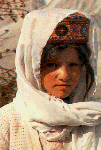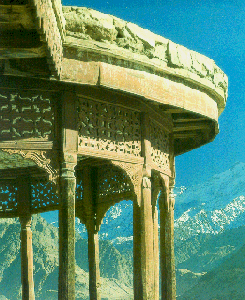 Kufi script rendered "Allah"
Kufi script rendered "Allah"His Highness the Aga Khan Visits Pakistan

Spiritual leader of Ismaili community Prince Karim Aga Khan willarrive here on Sept 27th on a 5-day visit to Pakistan, it wasofficially announced.
According to official sources, the Aga Khan will arrive at PAF BaseChakala Airport, by a special plane.
Soon after his arrival he will driven straight to theAwan-i-Saddar. He is expected to meet the President of PakistanFarooq Ahmed Khan Laghari and Prime Minister Banazir Bhutto andother high government officials.
Aga Khan will leave Islamabad for Gilgit on Sept 28 by specialplane. He will leave for Hunza valley the same day inaugurate the800-years old Historic BALTIT FORT (KARIMABAD FORT),once the abodeof rules of Hunza,which has been renovated by Karimabad ProjectSupport Service (KPSS), a project of the Aga Khan Cultural Servicefor Pakistan.
He will attend a ceremony at Karimabad Polo ground on september29,and also visit the BALTIT FORT (KARIMABAD FORT).
Aga Khan will leave for Gilgit on the same day where he will holdprivate meeting and attend a dinner.On September 30th, He willleave Gilgit for Hunza, where He will visit historical sites andsupport programme display and cultural workshop at the Aga KhanGirls Academy, Karimabad.

The same day,The distinguished guests will leave Hunza valley forGilgit.In the evening He will also attend a banquet reception atSERENA HOTEL hosted for the Ambassadors and for the HighCommissioners who are accompanying Aga Khan to Northern Areas.Aga Khan will leave Gilgit for Islamabad on October 1st, 1996 on aspecial plane.
According to the Aga Khan Council sources, Prince Karim Aga Khanwill also meet his followers (ISMAILIES) at Gilgit and HunzaValley.
Source: Daily Dawn Newspaper, Islambad Sept 24th,1996
His Highness Aga Khan's Speech 

Given at the Foundation Stone laying ceremony for the Hunza Girls Academy at Karimabad 1983
"The Aga Khan Academy here at Karimabad will be
our first High School and Hostel for girls in the Northern Areas and a
landmark in our progress in Pakistan"
To read the full text, click "new" above.
Baltit Fort in Hunza Inaugurated

Article from Pakistan Dawn 9-30-96 By Nizamuddin Siddiqui
KARIMABAD (Hunza Valley), Sept 29: President Farooq Leghari on Sunday described theBaltit Fort project here as a model development project for the developing world. Baltit Fort, a700-year-old landmark of Islamic architecture has been brought back to its former splendour bythe Historic Cities Support Programme (HCSP) of The Aga Khan Trust for Culture and nowreturned to the local community here.
Speaking on the occasion the president said: "This intervention effort is not limited just to thephysical restoration of the fort. The project represents a major undertaking both in the fields ofdevelopment and culture. The effort goes beyond just tourism".
President Farooq Ahmed Khan Leghari and Prince Karim Aga Khan were present at theinauguration ceremony as were more than 350 other guests from around the world.
The fort will now be run as a museum and a culture centre by a public foundation, the BaltitHeritage Trip. After turning into a museum and a culture centre, the Baltit Fort will be in a betterposition to contribute towards the economic, social and cultural development of the rapidlyurbanising village of Karimabad.
On this occasion the Aga Khan said: "As the prime
historic landmark of Hunza, the fort is amajor tourist attraction and a
potential source of income for the local community. It can,therefore, be
expected that the restoration project itself will act as a dynamic factor
of change." 
The signs of change are already evident, as recently as last week, a 50-bed hotel was opened here. The fort, which was described by C.P. Skrine in his book — Chinese Central Asia — as the"most impressively-situated mediaeval castle in the world," was restored at a total cost of $2.15million by the Aga Khan Trust for Culture. Getty Grant Programme and the Norwegian bilateralaid programme, NORAD, committed $200,000 and $450,000, respectively, to the restorationeffort. The restoration work was completed in about five years.
History of Baltit Fort: Karimabad, formerly called Baltit, is a settlement of 5000 inhabitants inHunza, one of the high valleys between China and the Subcontinent. Hunza was an autonomousfeudal kingdom ruled by a Mir until 1974, when it became part of Pakistan's Northern Areas.This change in status occurred simultaneously with the construction of the Karakorum Highway.The road connecting Kasghar with Islamabad suddenly put an end to the seclusion of the Hunzavalley, which had remained peripheral to the ancient Silk Route.
The history of the fort is not precisely known. It was only at the turn of the last century thatoccupying British forces compiled written descriptions and some photographic records.According to the local accounts, confirmed by recent scientific testing, the fort was built 700years ago and became part of a dowry when a princess of Baltistan married the reigning princeof Hunza. Until 50 years ago, it remained the residence of the Mirs of Hunza.
The plan of the building shows that it began with a nucleus of one or two fortified houses, whichthen evolved into a fort towering above the village. A second storey, and part of a third, wereadded at different moments over time.
The top storey was modified by adding verandas, thus transforming the structure from a fort intoa palace. The building was abandoned approximately 50 years ago by late Mir and his family infavour of modern premises.
Conservation of Baltit Fort: In 1990, the former Mir of Hunza, Ghazanfar Ali Khan, donated thefort to the BHT. This donation enabled the trust to sponsor the restoration work.
The conservation project had to cope with extraordinary structural, geotechnical and logisticalproblems, due to precarious condition of the building, the steep slope, the lack of soil stabilityand the remoteness of the area.
One of the HCSP's main objectives in this project was to introduce and promote internationallyrecommended conservation standards and practices in Pakistan. Whenever possible, originalconstruction techniques and materials were used for repairs, based on corresponding researchand experiments.
The site team has restored the physical shell of the building to a satisfactory state of structuralstability, including the strengthening of walls, floors and roofs. Minor functional adjustments wererequired for the use of the building as a museum and cultural centre, such as the addition of basicelectrical and plumbing services, etc.
The restoration of the building was also seen as an opportunity for training young conservationistsfrom Pakistan, as well as for the revival of traditional crafts, architects, engineers and localcraftsmen have benefited from the on site training process, complemented by seminars,workshops and special training courses from outside of the country.

| Present Imam Shah Karim Aga Khan IV | 48th Imam Mowlana Sultan Mahomed Shah Aga Khan III | Hazrat Ali | Prophet Muhammad | Ismaili Heroes | Navigation Tool | Poetry | Audio Page | History | Women's Page | Legacy of Islam | Current Events |
 Back to Ismaili Web
Back to Ismaili Web